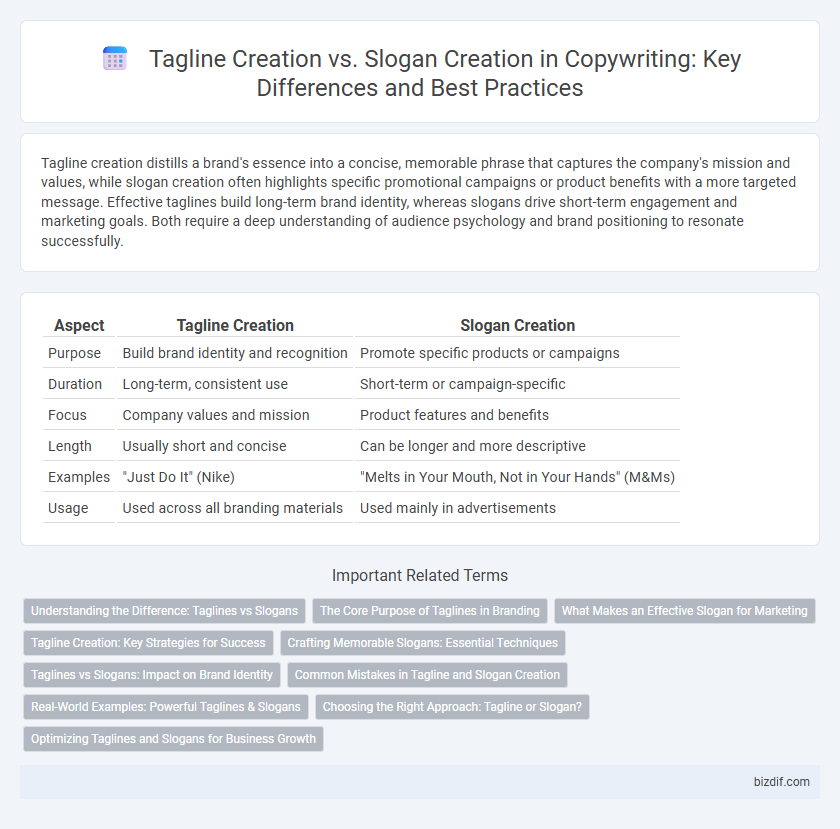Tagline creation distills a brand's essence into a concise, memorable phrase that captures the company's mission and values, while slogan creation often highlights specific promotional campaigns or product benefits with a more targeted message. Effective taglines build long-term brand identity, whereas slogans drive short-term engagement and marketing goals. Both require a deep understanding of audience psychology and brand positioning to resonate successfully.
Table of Comparison
| Aspect | Tagline Creation | Slogan Creation |
|---|---|---|
| Purpose | Build brand identity and recognition | Promote specific products or campaigns |
| Duration | Long-term, consistent use | Short-term or campaign-specific |
| Focus | Company values and mission | Product features and benefits |
| Length | Usually short and concise | Can be longer and more descriptive |
| Examples | "Just Do It" (Nike) | "Melts in Your Mouth, Not in Your Hands" (M&Ms) |
| Usage | Used across all branding materials | Used mainly in advertisements |
Understanding the Difference: Taglines vs Slogans
Tagline creation focuses on crafting a concise phrase that encapsulates a brand's core identity and promise, often used consistently across all marketing materials to build long-term recognition. Slogan creation targets specific campaigns or products, delivering persuasive and memorable messages that drive short-term engagement and action. Understanding the difference between taglines and slogans enhances strategic copywriting by aligning messaging with brand positioning and marketing objectives.
The Core Purpose of Taglines in Branding
Taglines serve as concise expressions of a brand's core purpose, encapsulating its unique value proposition and emotional appeal to foster immediate recognition and loyalty. Unlike slogans that often focus on specific campaigns or product features, taglines remain consistent across all brand communications, reinforcing the brand's identity over time. Effective tagline creation strategically distills the essence of the brand into memorable, emotionally resonant language that distinguishes it in a crowded market.
What Makes an Effective Slogan for Marketing
An effective slogan for marketing must be memorable, concise, and emotionally resonant, encapsulating the brand's core promise in a few impactful words. It enhances brand recognition by creating a lasting impression that differentiates the business from competitors. Successful slogans often use rhythm, rhyme, or wordplay to ensure they stick in consumers' minds and inspire brand loyalty.
Tagline Creation: Key Strategies for Success
Effective tagline creation hinges on clarity, brevity, and emotional resonance, ensuring the brand message is instantly memorable and impactful. Successful taglines highlight unique value propositions while maintaining consistency across all marketing channels to strengthen brand identity. Leveraging customer insights and market research enhances tagline relevance, fostering stronger connections and driving brand loyalty.
Crafting Memorable Slogans: Essential Techniques
Crafting memorable slogans involves focusing on brevity, emotional appeal, and clarity to ensure instant brand recognition. Effective slogans use rhythmic language, alliteration, or rhyme to enhance recall and connect deeply with target audiences. Consistent testing and refinement based on audience feedback optimize slogan impact and longevity in competitive markets.
Taglines vs Slogans: Impact on Brand Identity
Taglines distill a brand's core promise into a memorable phrase that shapes long-term brand identity, while slogans often highlight specific campaigns or products with a more temporary focus. Effective taglines such as Nike's "Just Do It" create emotional resonance and consistent recognition across all brand touchpoints. In contrast, slogans like McDonald's "I'm Lovin' It" drive immediate consumer engagement during marketing initiatives but may evolve more frequently.
Common Mistakes in Tagline and Slogan Creation
Common mistakes in tagline and slogan creation include using vague language that fails to convey the brand's unique value proposition, resulting in weak customer recall. Overcomplicating taglines or slogans with lengthy phrases dilutes their impact and reduces memorability. Neglecting audience relevance and emotional appeal often leads to disengagement, causing the message to miss its marketing goals.
Real-World Examples: Powerful Taglines & Slogans
Tagline creation distills a brand's essence into a memorable phrase, exemplified by Nike's "Just Do It," which motivates action and embodies athletic determination. Slogans often target marketing campaigns with a specific message, as seen in McDonald's "I'm Lovin' It," which enhances customer connection through consistent, catchy promotion. Both powerful taglines and slogans elevate brand identity by utilizing emotional appeal and clarity, demonstrated across leading global companies.
Choosing the Right Approach: Tagline or Slogan?
Choosing the right approach between tagline creation and slogan creation depends on brand objectives and marketing strategy. Taglines offer a concise, memorable phrase that encapsulates brand identity for long-term recognition, while slogans focus on specific campaigns or promotions to drive immediate engagement. Understanding target audience and campaign goals ensures effective messaging that maximizes brand impact and consumer connection.
Optimizing Taglines and Slogans for Business Growth
Optimizing taglines and slogans plays a crucial role in enhancing brand recognition and driving business growth by clearly communicating core values and unique selling propositions. Tagline creation focuses on crafting concise, memorable phrases that encapsulate a brand's identity, while slogan creation emphasizes persuasive messaging aligned with marketing campaigns to boost customer engagement. Effective integration of SEO keywords and emotional triggers in both taglines and slogans amplifies online visibility and fosters stronger connections with target audiences.
Tagline Creation vs Slogan Creation Infographic

 bizdif.com
bizdif.com